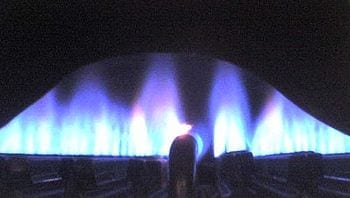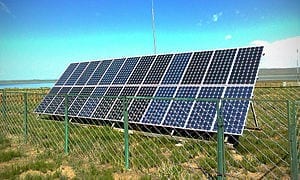
There’s a whole lot of methane in them thar seafloor. But is it good as gold or fool’s gold
Remember when shale gas was the next big thing? The game changer that would revolutionize the energy world, providing Americans with an abundant source of clean, environmentally friendly fuel?
Shale gas, undoubtedly, has turned out to be a big thing. Natural gas production has been steadily climbing since 2006, and natural gas prices are so low that gas is displacing dirty coal as the fuel of choice in our power plants.
But, with concerns over water pollution and air pollution from the process of horizontal drilling and hydraulic fracturing (fracking) — and global warming impacts (conceivably as bad as or even worse than coal) from natural gas leakages from the extraction and piping of the fuel — the bona fides of shale gas as an environmentally friendly fuel has been pretty well tarnished.
Now a new source of natural gas threatens to take shale’s position as the ultimate energy game changer of our times: methane hydrates.
Methane Hydrates: A Veritable Gold Mine?
A methane hydrate is an ice-like cage of water molecules in which a molecule of methane is trapped. Methane hydrates form at low temperatures and high pressures like those found below water depths of about 500 meters off the coasts of continents, in seafloor sediments and in permafrost. (More here, here and here.)
And here’s the thing. Geologists estimate that there are enormous quantities of methane stored in the ocean bottom as hydrates. How much is enormous? Would about twice the amount of carbon that is found in all the other fossil fuels meet the enormous criteria? (See here, here and here.)
But having a huge resource of methane sitting on the ocean floor is one thing; being able to extract the stuff economically and bring it to the surface is another. Just look how long it took for the commercial shale gas boom to develop. Decades from the time the first well was fracked.
And as the Deepwater Horizon blowout and its ongoing ripple effects highlight, moving into new areas of energy extraction is no easy task and could be fraught with accidents waiting to happen. (An interesting aside: methane hydrates compounded the tricky business of trying to seal the Deepwater Horizon leak.)
So economics, technology and scientists’ relatively poor understanding of methane hydrates have seemingly conspired to keep the natural gas locked in these hydrates at bay … until just about now.
Move Over, Shale. Methane Hydrates’ Turn?
The Latest Bing News on:
Methane Hydrates
- Revolution in Methane Detection: Scientists Achieve Groundbreaking 500-Fold Sensitivity Increaseon May 5, 2024 at 1:24 pm
A research group headed by Professor Chen Chilai from the Hefei Institutes of Physical Science of the Chinese Academy of Sciences has significantly enhanced the detection sensitivity of dissolved ...
- Underwater mass spectrometry achieves 500-fold sensitivity enhancement for dissolved methane detectionon April 29, 2024 at 1:35 pm
A research team led by Prof. Chen Chilai from Hefei Institutes of Physical Science of Chinese Academy of Sciences, amplified the detection sensitivity of dissolved methane in water by over 500 times, ...
- Australia's Major Emitters May Spew Twice More Methane Than Reported: Studyon April 29, 2024 at 7:50 am
Major polluters in Australia may be spewing more than double the methane estimated in its national inventory data, according to a report from the Melbourne-based nonprofit The Superpower Institute ...
- Indian Ocean & Bay of Bengal potential CO2 sinks: IIT Madras studyon April 29, 2024 at 3:33 am
The Indian Ocean and the Bay of Bengal are potential sinks for storing large amounts of carbon dioxide (CO2), according to a study by the Indian Institute of Technology (IIT) Madras released on Monday ...
- Estimating emissions potential of decommissioned gas wells from shale sampleson April 24, 2024 at 5:00 pm
Feb. 20, 2020 — As global temperatures rise, permafrost and methane hydrates -- large reservoirs of ancient carbon -- have the potential to break down, releasing enormous quantities of the ...
- Methane hydrate: Dirty fuel or energy saviour?on April 13, 2024 at 5:00 pm
The problem is it's a hydrocarbon, but quite unlike any other we know. Otherwise known as fire ice, methane hydrate presents as ice crystals with natural methane gas locked inside. They are formed ...
- Kick-starting ancient warmingon April 12, 2024 at 10:47 am
Sources including the release of methane during the intrusion of magma into organic-rich sedimentary rocks, carbon dioxide outgassing from lava flows, and dissociation of methane gas hydrates in ...
- Explosive levels of methane have been detected near a Berkeley landfill-turned-parkon April 10, 2024 at 5:00 pm
But beneath the sprawling grasslands and charming hiking trails, decomposing waste continues to generate methane gas. That’s why the city of Berkeley operates an underground system that collects ...
- EU lawmakers adopt law to hit fossil fuel imports with methane emissions limiton April 10, 2024 at 10:30 am
BRUSSELS, April 10 (Reuters) - European Union lawmakers on Wednesday adopted a law to place methane emission limits on Europe's oil and gas imports from 2030, pressuring international suppliers to ...
- Methane from landfills is detectable from space – and driving the climate crisison April 9, 2024 at 8:44 am
Landfill trash is the third-largest source of human-caused methane pollution in the US. To fight global heating, curb waste An elusive climate menace is now easier than ever to see. In early March ...
The Latest Google Headlines on:
Methane Hydrates
[google_news title=”” keyword=”Methane Hydrates” num_posts=”10″ blurb_length=”0″ show_thumb=”left”] [/vc_column_text]The Latest Bing News on:
Natural gas
- How to invest in natural gas stockson May 10, 2024 at 3:00 am
Governments and companies around the world are counting on natural gas to be a bridge fuel away from coal amid the global transition to renewable energy. It can provide base load power, the minimum amount required over a given time period at a constant ...
- Natural gas, power prices turn negative in Texas, California, Arizonaon May 7, 2024 at 8:31 am
Spot power and natural gas prices turned negative in Texas, California and Arizona as pipeline maintenance trapped gas in the Permian Basin, Reuters reported Tuesday. Energy traders have said for weeks that gas prices at the Waha hub in West Texas likely would turn negative when Kinder Morgan (KMI) started conducting seasonal maintenance on
The Latest Google Headlines on:
Natural gas
[google_news title=”” keyword=”natural gas” num_posts=”10″ blurb_length=”0″ show_thumb=”left”]










